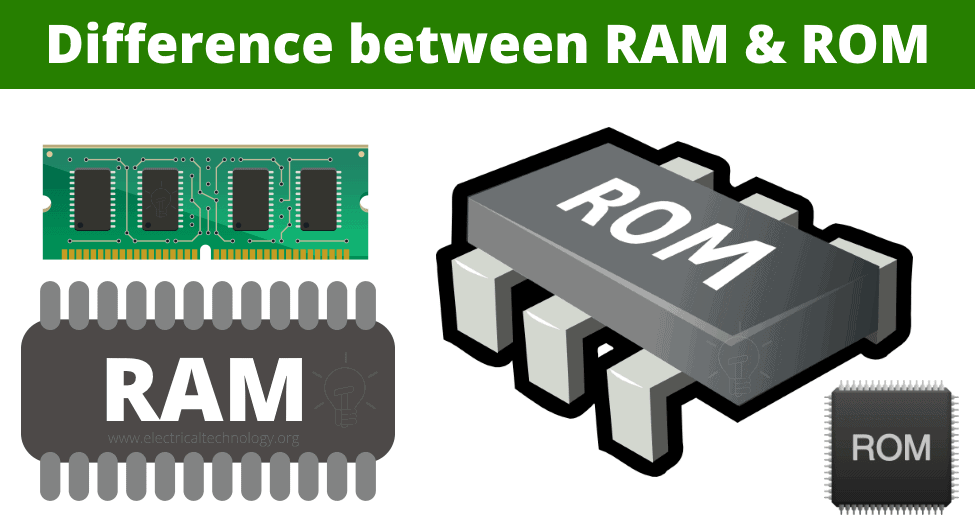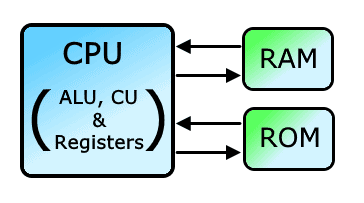Difference Between RAM and ROM – Comparison
Difference Between RAM (Read Only Memory) and ROM (Read Only Memory
The memory is the essential component or circuit of any electronic device that needs to store information. The information is stored in the digital format of either “0” or “1” also known as the binary format. The electronic circuit used for storing the digital data or information is called the memory and the building block of memory that stores only a single bit of data is called a memory cell.
RAM and ROM are the two types of memories used in microcontrollers or computers. They are both used for storing information and they both belong to the classification of primary memory which is the memory directly accessed by the CPU.
RAM and ROM are two very different computer memories that differ from each other based on its usage, storage feature, capacity, speed, etc. Before going further into the differences between RAM and ROM, let’s discuss a little bit about them.
RAM (Random Access Memory)
RAM is an acronym for Random Access Memory. It is a type of primary memory that stores the information currently being used by the CPU. The information could be the data being processed or the program code. It is a read-write memory meaning it can do both stores (write) and access (read) the data at almost the same time. But the RAM is a volatile or temporary memory i.e. its content erases when the power source is removed.
The RAM is a fast access memory because it can store and access the data randomly at any time regardless of its physical location. It stores the necessary instructions required for starting the device and the data being used by the processor. It increases the processing speed of the system by quickly transferring the data between the components.
The RAM has two types DRAM (Dynamic RAM) and SRAM (Static RAM), please refer to the article “types of memory” to know more about its types and advantages over each other.
ROM (Read Only Memory)
ROM or Read Only Memory is also a type of primary memory but it stores the data permanently. It is a non-volatile memory i.e. the content of its data does not get erased when the power source is removed.
As the name suggests, it is a Read-Only memory, meaning the data cannot be altered but it can be accessed any number of times. The CPU can only access the data and cannot write it. The program or code is stored in the ROM during its manufacturing. Although there are some modified versions of programmable ROM such as PROM, EPROM and EEPROM (refer to the article “Types of memory”) that can be reprogrammed several hundred times using special devices.
The ROM stores the necessary instruction required for booting up the device or the program code for the device. The data stored is not directly accessible by the CPU thus the RAM is used for temporarily storing the data prior to access by the CPU.
- Related Post: Difference Between CPU and GPU – Comparison
Main Differences between RAM and ROM
The following tabular form shows the comparison between RAM vs ROM.
| RAM | ROM |
| It stands for Random Access Memory. | It stands Read-Only Memory. |
| It is also known as Data Memory. | It is also known as Program memory because it stores the program code. |
| It is a Read-Write memory i.e. the data can be stored and accessed by the CPU. | It is a Read-Only Memory i.e. the data can be only accessed and cannot be re-write or altered by the CPU. |
| It temporarily stores the data. | It permanently stores the data. |
| It stores the data that is currently being used by the CPU. | It stores the program code or instructions needed at the boot-up or start-up of the system. |
| It is a volatile memory i.e. the data is erased when the power supply is removed. | It is a non-volatile memory i.e. the data kept stored regardless of the removal of power supply. |
| It needs a constant supply of power to retain its information. | It does not need a power supply to retain its data. |
| It is directly accessed by the CPU of the system. | The data is transferred to RAM prior to access by the CPU. |
| The RAM is available in fairly huge storage capacity measured in GigaBytes. | The ROMs have very low capacity measured in MegaBytes. |
| It helps in increasing the processing speed of the system because it is directly accessed by the CPU. | It does not help in increasing the speed of processing. |
| The RAM is comparatively expensive than ROM. | The ROM is cheaper than RAM. |
| The RAM is classified into two types; Static RAM (SRAM) and Dynamic RAM (DRAM). | The ROM is classified into PROM, EPROM, and EEPROM. |
- Related Post: Difference Between Microprocessor and Microcontroller
Advantage of RAM over ROM
- The RAM can do both read and write operations i.e. it can store the data and also allow you to access it. While the ROM does not allow its data to be rewritten. Its content can only be read without any writing capabilities.
- The RAM has very fast operational speed while the ROM is relatively slower.
- Increasing the capacity of RAM increases the processor’s speed while the ROM capacity does not affect the speed of the processor.
- The RAM is directly accessible by the CPU while the content of ROM needs to be transferred to ROM before processing.
- The RAM is available in very large capacities and it can store data in a range of Gigabytes while the ROM stores the startup or program code ranging in Megabytes.
Advantage of ROM over RAM
- The ROM Permanently stores the Data while the RAM temporarily stores the data.
- The ROM does not need electricity to retain its information while the RAM needs constant power source.
- The ROM is relatively cheaper than RAM.
- The size of the ROM chip is smaller the RAM.
The Conclusion of this article is that we cannot replace the RAM and ROM with each other. A system needs both types of memories to perform perfectly and efficiently. The RAM is used for storing the data for processing and the ROM is used for starting the system.
Related Posts:
- Difference between Analog and Digital Circuit – Digital vs Analog
- Difference between Inverter & UPS – Uninterruptible Power Supply
- Difference Between Inverting and Non-Inverting Amplifier
- Difference Between Amplifier and Operational Amplifier
- Difference between Voltage Source Inverter & Current Source Inverter
- Main Difference Between Sensor and Actuator
- Main Difference between Sensor and Transducer
- Difference Between Encoder and Decoder
- Difference between Active and Passive Components
- Difference Between BJT and FET Transistors
- Difference Between NPN and PNP Transistor
- Difference Between Active Transducer and Passive Transducer
- Difference Between Multiplexer (MUX) & Demultiplexer (DEMUX)
- Difference Between Digital Latch and Flip-Flop Circuits
- Difference Between Edge Triggering and Level Triggering









A good way to disseminate knowledge.
Hiii I am Nasir Khan Electrical
Very very much help you